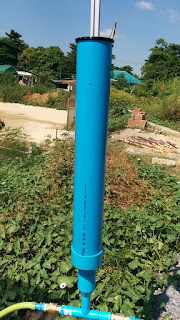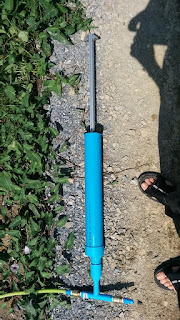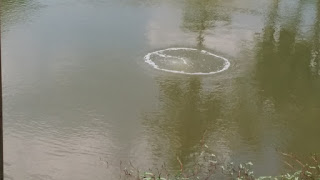The first prototype air pump test I did at the beginning of the month was basically a proof of concept test. It worked well enough to adjust dimensions to a more deployable size and today the second prototype was ready for test. Here are a few pictures of it:
We increased the size of the PVC pipe for increased volume. The main reason for this was the theory that the friction should be proportional to the contact area which should be roughly the length of the O-ring seal. This is proportional to the circumference of the pipe. The amount of air per cm of piston travel is proportional to the cross sectional area of the pipe. So doubling the piston diameter should roughly double the O-ring contact area and friction, but quadruple the volume of air being pushed. Thus increasing efficiency.
The larger piston diameter also allows for a shorter piston throw making the mechanical design of a motorized crankshaft a bit easier, too. Additionally, the larger piston volume allows the piston to move at a much slower speed for the same volume of air pumped, which should reduce wear and tear. At least this is the theory.
Finally, we used a higher pressure rating PVC pipe to increase the safety factor a bit. It is worth repeating the safety warning from the previous test:
WARNING: It must be noted that it is dangerous to use PVC pipe for high pressure compressed air applications. Here is a page on the subject. There is a note at the bottom that you should leave “large factors of safety” due to PVC’s tendency to explode unsafely if it ruptures while holding a compressed gas. The pressure we need is about 0.3 bar, while the PVC we are now using is rated at 8.5 bar. This appears to be a very large safety margin. Nonetheless I will likely look into other options when I build the actual pump. Part of this is due to the fact that PVC weakens quickly at higher temperatures, and compressed gases can rise to high temperatures. While the pressures we are talking about are a small fraction of what most people refer to as “compressed air”, it still isn’t worth taking chances. DO NOT TRY THIS AT HOME. You have been warned.
With that said, this second prototype really worked nicely. The amount of air it was able to pump into the water, and the smoothness of the piston throw makes me think it is ready to be motorized. We will be trying to get a 24V DC windshield wiper motor hooked up to a crankshaft to drive it. Here are some pictures of the air bubbles coming up. (Not the most interesting pictures in the world, but I include them for completeness. I’ll try to include some video once we successfully get it motorized.)




